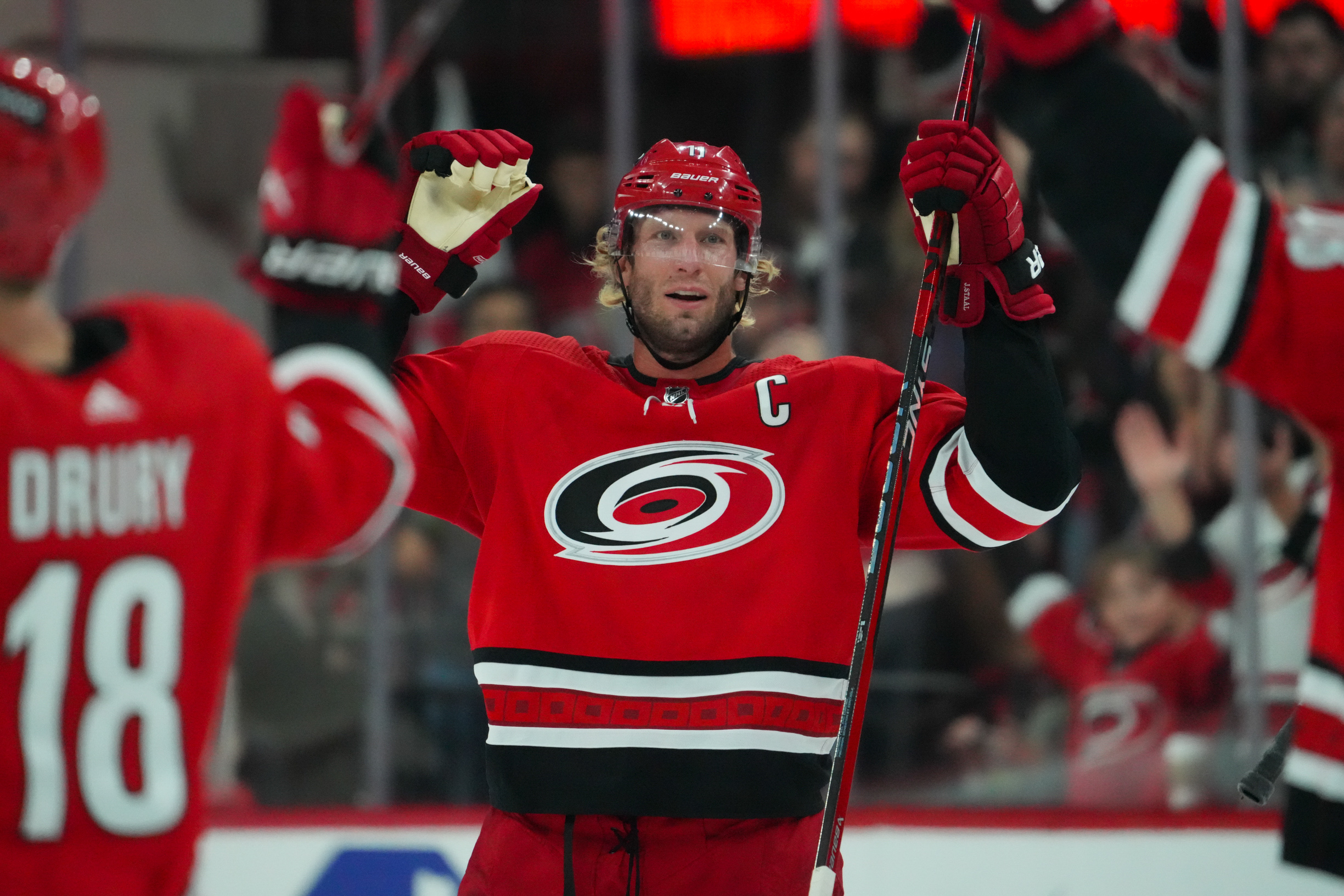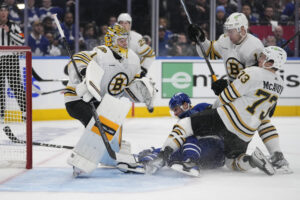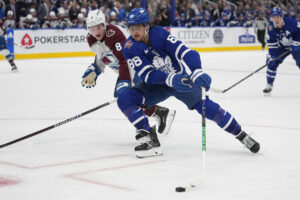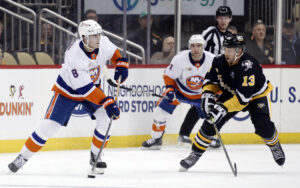The Carolina Hurricanes are moving along into the 2023-24 season. And it’s been an interesting one, to say the least. The team sits near the top of the Metropolitan Division with a record of 9-6-0 but other teams are right in the mix too, many with games in hand. There are a lot of highs and lows from the early season and we aren’t claiming to discuss them all. But 15 games into the season, we take a look at some of the hits and misses (and in-betweens) from the early part of the year.
How’d We Get Here?
After an exciting offseason, the first handful of games saw the Hurricanes playing a game that was completely upside down from their norm. The goals were pouring in….on both sides of the ice. The special teams were anything uniform with ups and downs in different aspects. And arguably still, the Hurricanes have maybe played two “complete” games. But here they are.
Since about the first six games, however, they have settled into their game and newcomers such as Dmitry Orlov seem to be adjusting. Injuries have been somewhat erratic as Andrei Svechnikov missed the first few games, Frederik Andersen missed a few and now is out indefinitely with a blood clotting issue, and Brett Pesce and Sebastian Aho also missed some time.
Hurricanes Early Season Hits
The Hurricanes “Finn”ishing
There are a few widely accepted thoughts and observations concerning the Hurricanes. One is that they love to generate shots and rely on the defence and a heavy forecheck for offence. Another is that compared to the sheer number of chances they generate, they could look to improve in converting more chances to goals. Some of that is a question of system versus personnel. And another observation is that the Hurricanes top-six forwards are comprised of 50% Finnish players. Aho is a franchise piece while Jesperi Kotkaniemi and Teuvo Teravainen walked into the season looking to prove pundits wrong.
Through the first 15 games, it is these Finnish players leading Carolina’s offensive charge. We previously took an in-depth look at Jesperi Kotkaniemi and Teuvo Teravainen in an article here. Kotkaniemi is tied with fellow Finn Aho for team lead in points. Teravainen leads the team in goals and game-winning goals. All three have consistently played in the team’s top six and on the power play and penalty kill. Aho is producing in typical Aho fashion. Kotkaniemi is getting to the net and leaning into his skill set. Meanwhile, Teravainen is simply shooting more. And shooting better. When your top two centres, and 50% of your top six forwards, are leading the offence, the utilization seems appropriate.
The…the Power Play??
The Hurricanes penalty kill has typically been a strength while the power play has been a fairly big weakness the last few years. When it comes to the playoffs especially, having an effective power play can be crucial. Chances are limited and taking advantage of opportunities can make or break a team. This was one of the biggest questions facing Carolina going into this season. By adding Michael Bunting and Tony DeAngelo, and to a lesser degree Orlov, Carolina was hoping for some help on the power play.
So far, the power play is actually working. Besides giving up some shorthanded goals against, this has been a strength of the team. Their 25.5% power play effectiveness puts them in the top ten in the league. Their 13 goals for at 5v4 play is fifth in the league. But what has changed?
What Gives?
That answer appears to be multi-faceted. The newcomers have helped some for sure. DeAngelo, even with his defensive shortcomings, excels offensively. He is specifically lethal quarterbacking the power play. He can skate well at the blue line, has great vision to move the puck around, and when needed can rip shots from the top of the key. This also allows last year’s PP1 quarterback Brent Burns to slide to PP2 and balance out the groups. Bunting has a shoot-first mentality and is especially good in tight around the net. He and Noesen are great in tight while Kotkaniemi and Jordan Staal utilize their bigger bodies to screen the goalie and get tips. Seth Jarvis has found a groove on the power play too after coming up fairly empty last year. So the mix of newcomers plus others finding their game on the power play is contributing.
But their actual power play is working quicker and with more crispness in their execution. Instead of three guys standing at the top of the umbrella looking at who would take the next shot, they are working the puck around quickly. Many times the guys at the dots move the puck to the low man below the goal line and quickly break to the net for either a one-timer or to switch spots as the low man steps out to the half boards. This will require the penalty killers on that side to adjust coverage. Any time you can get the penalty kill to move and break its structure, the chance of goal-scoring drastically increases.
Overtime
Whether it is the work ethic and skill of Aho or the speed and creativity of Martin Necas, Carolina has found a way to win every game that has gone to overtime so far (and one shootout). Necas is second in the league in overtime goals and has seven since the 2021-22 season which leads the NHL. When Necas and Aho are on the ice together, it creates magic. They seem to have a sixth sense and the extra room on the ice allows their speed and skill to shine. This could not be any clearer than Martin Necas‘s overtime goal against the Buffalo Sabres.
MARTIN NECAS! OVERTIME WINNER! Hurricanes win 3-2!#CauseChaos pic.twitter.com/jwyF1lWGdV
— Hockey Daily 365 l NHL Highlights & News (@HockeyDaily365) November 8, 2023
Reasons for Success
There are a few takeaways here. As Aho circles around the net and Brady Skjei is ready for the pass, Necas is already working his way through the high slot in an opposite direction. Immediately when Necas gets the puck all three players converge in the same spot. This makes the Sabres defence almost collide in one spot. As Skjei slowly floats and sets somewhat of a screen, Necas dishes a drop pass to the circling Aho. This worked so well due to how closely Aho skates by Necas. Then, as soon as Necas drops the puck off he circles the opposite direction of Aho’s path and goes immediately to the backdoor of the net without hesitation. Aho turns on the jets to complete his route and looks up.
If you pause the video at about seven or eight seconds, you see that Necas is open on the back door as the Sabres took too long to figure out coverage after the Hurricanes passing. While Aho hits Necas at the back door and that’s the game, he actually could have hit Skjei in the slot as well. Essentially, through this unique passing play with movement and positional trading, the Sabres were left in no-mans land trying to figure out who to cover. Meanwhile, every Hurricane player was open for a scoring chance. This creativity combined with the defence’s ability to skate offensively is what is making Carolina so successful at overtime so far.
Hurricanes Early Season Misses
Tony DeAngelo
Tony, Tony, Tony… Everyone’s favourite punching bag. DeAngelo is not exactly a secret around the league. An insanely gifted offensive defenceman with an equally insanely poor defensive ability. Not to mention the constant “attitude” questions. He didn’t really work out with the New York Rangers, had a surprisingly good stint with Carolina, then didn’t work out with the Philadelphia Flyers. It seemed like possibly only Rod Brind’Amour could connect with the offensive defenceman. So the Hurricanes took him back in the offseason.
They knew what they were getting. A defenceman to provide offence and especially help on the power play. And so far he has been a pretty good piece on the team’s top power play unit. But beyond that, the reunion has been a little shaky. His offensive statistics are fine with one goal and five assists. His goal and four of those assists all came on the power play. Meanwhile, he is a -8 which is a far cry from his +30 the last time he was with Carolina (I know this stat is a little unreliable but still worth mentioning). His expected goals against per 60 minutes is middle of the pack at 2.38 but his expected goals for is only 0.9. Not exactly earth-shattering for an offensive defenceman. Meanwhile, his on-ice goal percentage is 50% while his on-ice goal differential is 0.
And these numbers are much worse at 5v5 where his -7 goal differential is near the bottom of all Hurricanes players. He is the only defenceman without an even-strength goal and his normal and advanced offensive statistics are largely inflated due to his power play effectiveness. The thing about DeAngelo is simply the question of whether his power play production outweighs his (so far) 5v5 ineffectiveness. While everyone started slow defensively, he and Orlov as a pairing seemed all out of sorts. Missing assignments, miscommunication, failure to cover, it all seemed constant. It has improved lately but the Hurricanes have been rumoured to have been gauging the trade market for DeAngelo. The reunion could be short.
A Complete Game
Even though Carolina has a winning record and is sitting in an alright spot, they really have not played a complete 60-minute game except maybe their two shutout wins. One of those was against the struggling San Jose Sharks and the other was against a Tampa Bay Lightning squad without Nikita Kucherov. Not to say Carolina didn’t play great those games, because they did, but just pointing out some disclaimers. Brind’Amour preaches over and over how in the NHL you cannot let your foot off the gas or “take a breath” for a second. If you do, most of the time the puck ends up in your net. The league is simply too good and the margins for error are razor thin.
It’s not fair to expect this all 60 minutes of all 82 games. But great teams do this more than less. And when it comes to playoffs it’s even more important. You want to go all the way? There can be no time off and no passengers. As Carolina has started settling into their game lately and the newcomers are slowly adjusting, we may start to see the team exhibit its potential. But for now, they have been scraping by more than they would like it seems.
The In-Betweens and TBDs
Brent Burns
Brent Burns has been a great addition to the Carolina Hurricanes. He is a big presence with a positive effect on the team on and off the ice. He settled in nicely on the top-pair defensive unit with Jaccob Slavin and offensively produced last season at a record-breaking pace for the organization. Burns is a guy who has been in the league for what feels like forever. Unfortunately, he has never won a Stanley Cup. He’s one of those guys that many would like to see win a Cup, regardless of their fandom.
Again this season, expectations were large for the top defenceman. And while he has not been terrible, he has looked a little shaky so far. To be fair, the whole team defensively was rocky for the first half of this season. So just by watching him the conventional eye test says he is off.
The Peak-End Rule
This can be exacerbated by a concept known as the “peak-end rule” where you remember the end of a game as well as the peak or most crucial moments. What I mean is that for example, Burns had a bad turnover at the blue line against the New York Islanders that led to a shorthanded goal against. And he has had a few gaffs like this where he looks a little uncomfortable. But the gravity of a blue line turnover leading to a shorthanded goal sticks out in everyone’s mind and shapes opinions. The reality is Burns is doing okay if you look at the bigger picture statistically.
What Picture the Stats Paint
Unfortunately, Burns sort of set himself up for failure in building expectations with how good he was last year. He currently has three goals and three assists and is a +2. One goal and two assists were on the man advantage. Not too bad honestly. He is also second on the team in shots with 39. Even on the advanced analytics side, Burns is leading all Hurricanes defencemen in expected goals with 2.2 and is scoring above expected.
However, his expected goals percentage is near the bottom of all Hurricanes skaters at 46.7%. Burns is actually at the bottom in expected goals against per 60 minutes at 3.79. The reality seems to be that Burns is where he belongs statistically. The beginning of the season didn’t help anyone but I would expect Burns to be just fine. He is older but still an extremely hard worker with great conditioning. Everyone wants to see top-pairing offensive defenceman Burns but even if he slows some, that doesn’t mean he is bad.
The Third (or Maybe Fourth) Line
Our final subject of attention takes a look at the Hurricanes third line. Or maybe the fourth line depending on how you look at it. This is the line of Jordan Martinook, Jesper Fast and Jordan Staal. This line is the ultimate picture of Rod Brind’Amour hockey. Hard-working, defensively responsible, heavy on the forecheck, and constantly firing on net. For all lines in the NHL that have played at least 100 minutes, they lead in expected goal percentage with 71.6%, almost 5% higher than the next-best line. They also have the lowest expected goals against at 2.7. Meanwhile, other areas they lead the NHL include Corsi and Fenwick as well as shots for and against per 60 minutes. They are an analytical dream and possess the puck extremely well. Not to mention they actually have zero goals against so far.
So why are they in the “in-between” category? Because this line, with all of its chances and possession, relatively struggles to convert. Compared to their expected goals of 6.8 they have only converted four times. This seems even more drastic when you look at four goals compared to their 193 shots for. As a checking line, they are about as effective as you could want. But in today’s NHL, where really all four lines need to be scoring, you’d like to see them convert a little more. And it’s likely to pick up. We are still early in the season and at some point, you expect to see them start providing some increased depth scoring. None of the three are a sniper but gritty goals count just the same. Whether you want to call this line the third or fourth line, at some point you hope to see the puck luck improve.
Main Photo Credit: James Guillory-USA TODAY Sports






